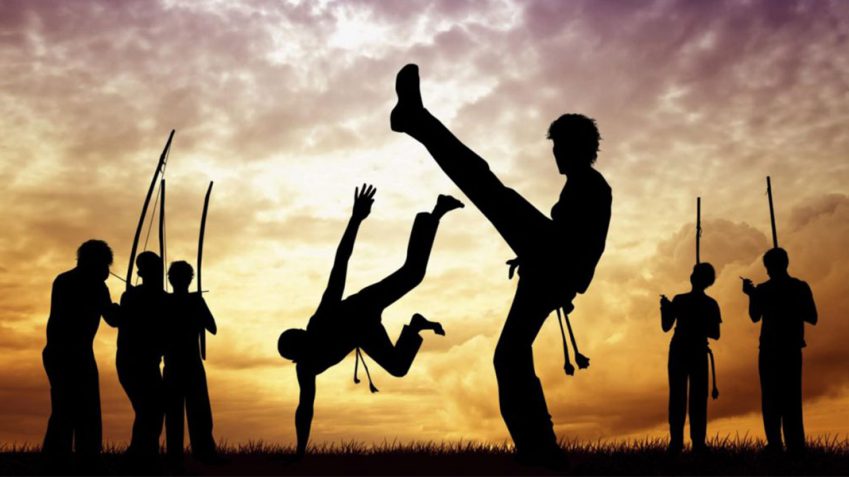ADVERTS
Capoeira has its origins in Africa, brought to Brazil by the hands of slaves, as a form of defense. It's a mix of dancing and fighting. To the rhythmic and well-defined sound of the belly berimbau, caxixi, atabaque, pandeiro and reco-reco, two participants rehearse synchronized choreographies, swaying with legs, arms, hands, feet, head and shoulders.
There are variations, which are Capoeira de Angola, its precursor being called Mestre Pastinha and Capoeira Regional, the latter differentiated by the introduction of moves called “ligados” and “cinturados” introduced by Mestre Bimba.
ADVERTS
The Capoeira Roda is divided between fighters and instrumentalists (responsible for the tone and marking of the capoeiristas). The berimbau is the main instrument, intoning and guiding the rhythm of the performance.
It is known throughout the world and is masterfully dominated by Bahians. The strongest manifestation is in Salvador, Cachoeira, Mata de São João, Santo Amaro, São Félix, Feira de Santana, Maragojipe and Nazaré.

She is the symbol of the resistance of the African people. Developed and perfected as a form of defense in quilombos, devices were taught that were prohibited, and movements were adapted with African songs and music, to be confused with dance. The practice of Capoeira took place in terreiros close to the slave quarters and its main functions were to maintain culture and physical health, in addition to relieving the stress of work.
ADVERTS
Its name comes from the fields with small bushes, called capoeira or capoeirão at the time.
Capoeira was banned in Brazil until 1930, the year in which Mestre Bimba presented the then president Getúlio Vargas with a more harmonious variation of the fight. The president was enchanted by the presentation and transformed it into a Brazilian national sport. In this way, Capoeira Angola was perfected in Bahia, remaining faithful to traditions.
Considered as a dialogue between bodies, the winner is the one who did not receive a response from their partner. In the capoeira circle, the two capoeiristas cross themselves at the foot of the berimbau and begin a slow ballet of questions and bodily answers, until a third joins the game, and so on, until everyone participates.
Malícia or mandinga is a fundamental element of capoeira. It consists of a game of going and not going, leaving and returning quickly; a body swing that deceives the opponent. Therefore, Capoeira is different from other martial arts.
It has three styles that differ in movements and accompanying musical rhythm. Capoeira de Angola has a small number of moves, but can reach harmonious complexity through its variations. Capoeira Regional is characterized by the mixture of the malice of Capoeira de Angola with the fast game of movements, to the sound of the berimbau. The blows are quick and dry, and acrobatics are not used. Contemporary Capoeira combines a little of the first two styles (Angola and Regional) and is the most practiced today.
The most purist practitioners do not admit the possibility of framing capoeira within sporting rules. They consider those who do this to be frivolous or laypeople. Other practitioners believe that the game must evolve like all martial arts.
According to the variations, Capoeira is supported by seven main moves: Headbutt, Rasteira, Rabo de Arraia, Chapa de Frente, Chapa de Costas, Meia Lua and Hand Cutilada.
É a única modalidade de luta marcial que se faz acompanhada por instrumentos musicais. O principal instrumento, o berimbau, era um instrumento usado por vendedores ambulantes para atrair fregueses, mas tornou-se instrumento símbolo da Capoeira, por conduzir o jogo com o seu timbre peculiar.
Os ritmos são em compasso binário e os andamentos – lento, moderado e rápido. Entre os mais conhecidos estão o São Bento Grande, o São Bento Pequeno (mais rápido), Angola, Santa Maria, o toque de Cavalaria (que servia para avisar a presença de polícia), o Amazonas e o Luna. Na roda de angoleiros o conjunto rítmico é composto por três berimbaus (um grave – Gunga; um médio e um agudo – Viola); dois pandeiros; um reco-reco; um agogô e um atabaque.
A parte musical é composta de ladainhas, cantadas e repetidas em coro por todos participantes da roda. É considerado bom capoeirista o que sabe tocar e cantar os temas da Capoeira.
